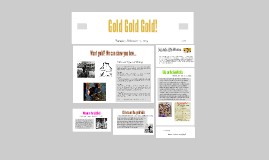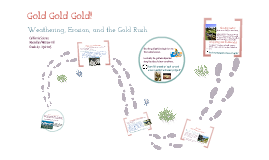Gold Gold Gold!
Transcript: When the goldrush began, many people left there jobs to hopefully find fortune on the goldfields. Nearly all of the shops closed down because no one was left to work at them (apart from the women and kids). Nor anyone to shop at them. Schools had closed down because there is no one to teach the children. The sale of alcohol was banned from the goldfields due to bad behavior it caused. Although some people had other plans. Sly grog shanties were built to sneak alcohol because to get beer or other drinks on the goldfields was more expensive than importing it from other country's, some of the drinks that they had on the goldfields were, spirits, whisky and gin. The miners diet consisted of mutton,damper and tea. The mutton was sold by butcher, who has a tent set up at the camp. The tent was always easy to find because flies were attracted to all the mutton. Fresh food such as fruit and vegetables were rare because before the food could be taken to the goldfields it got spoiled or rotten. Clean water was also very hard to find. The Government created a money system by forcing the diggers to own a gold license or miners right. Each month every miner had to pay 1 pound 10 shillings simply for the right to dig. Miners were not aloud to claim or say they own that part of land while they work otherwise they would get a large consequence. In the 1800's there were 7,000 chinese people on the goldfields. That was at least Half of the people that were at the goldfields! Australia first became multi-cultural during the gold rush period. the draw towards however took a personal toll on individuals. Particularity on the people that didn't speak English, which was NOT right. The Chinese were always working hard, with techniques that were wildly different from the Europeans. The Chinese had found out that Australia had found some tracings of gold and of they went to come look for gold for themselves. The Chinese workers have to follow the same rules as the Australian miners do so it is quite fair. Some of the miners caused trouble in the goldfields. In the first few years of mining ladies and children were rare on the goldfields, so while the family stayed home the men of the family only got to go digging for gold. Most of the men also thought that they didn't want there wives to risk going out to the harsh life at the goldfields. Only the children over 9-12 were allowed on the goldfields. Most of the children got to help out with the 'fun' of gold mining. They used small pans or dishes and went to small creek beds and they know that they have to get all the big rocks out to wash them and shake to let the heavy gold stay at the bottom. women you have to stay at home because its a high risk going out to the goldfields, just stick with what your good at, cooking,cleaning and caring! New to the Goldfields? How do you know which mining type suits you the best? Let our article tell you all about the different types of mining techniques you could be a part of! Panning * Panning is a simple technique used for finding alluvial gold (nuggets or flecks). Found in shallow creek beds. Cradle * This a large wooden cradle to find little gold particles through all of the dirt, sand and gravel. You put I big buckets of dirt and shake it to reveal the gold. Puddling * This used to separate gold from clay. The gold mixture is placed into a large container and then water is poured in. The mixture is stirred with a wooden stick and the water dissolves so you can grab your gold out of the container. Shaft Mining * When gold became popular under the surface of the ground miners turned to digging deep holes into to the ground or shafts to be specific. Good luck finding gold however you decide to look for it! Written by Abigail Hogg Life on the Goldfields Women on the Goldfield 2pence Tuesday, February 17, 1854 Thank you for reading this months issue of ''gold gold gold'' Make sure you have your license! Tools make all the difference... Want gold? We can show you how... The Chinese didn't want to work with the Australian miners because they had different opinions on things Looking for gold different people have types of techniques of the what tools miners should use, some are, cradles, panning, puddling, shaft mining and a miners pick. For these items to find any gold you have to use them correctly. Here are some of the things that you will need to require for these tools, for a pan you will need either dirt for dry panning or some sort of water for wet panning. For shaft mining you will need rope, the pulling machine, (or a couple very strong men), safety protection and tools, such as a bucket, shovels and/or pales. For puddling you will need a wooden crate or box, a wooden stick and this could also be mixed using the machine for puddling run by a horse going around in circles. For Cradles you will need the wooden/metal cradle and your hands, (to shake the dirt and water out to leave nice fresh gold). For a miners pick you wont need specific items

















